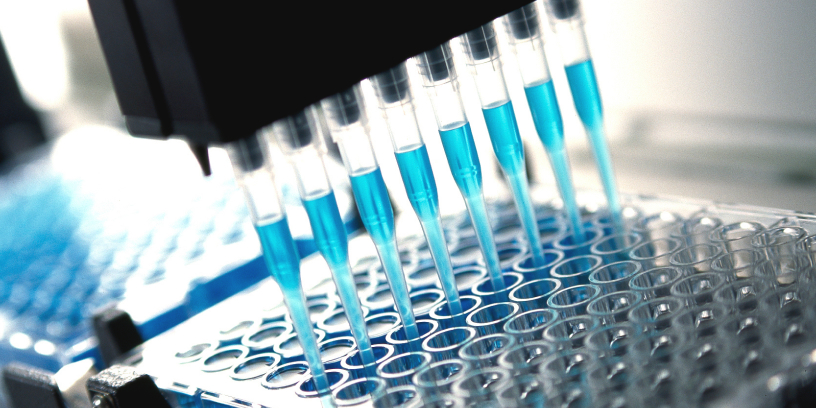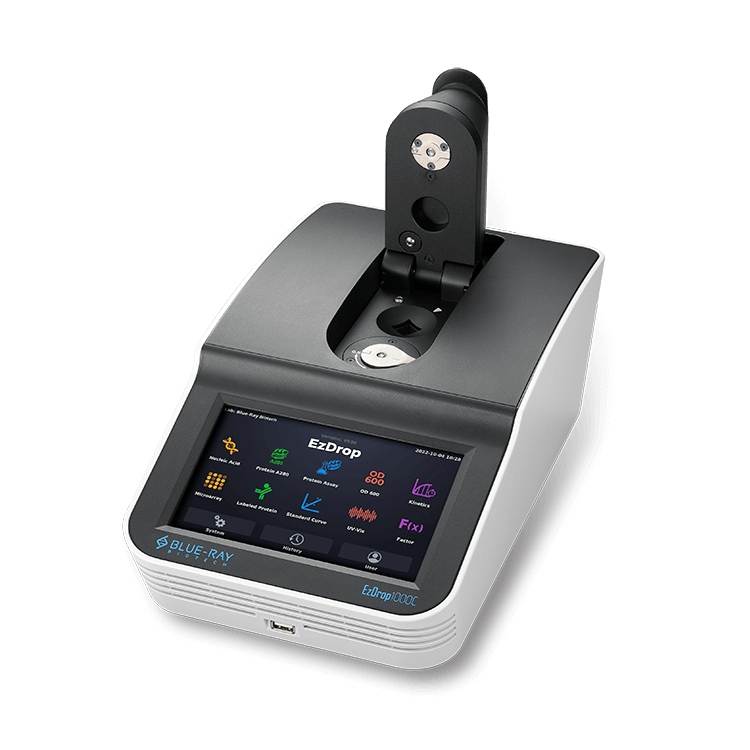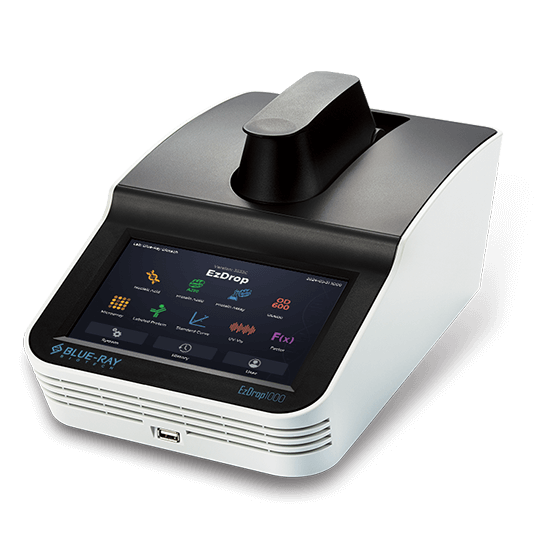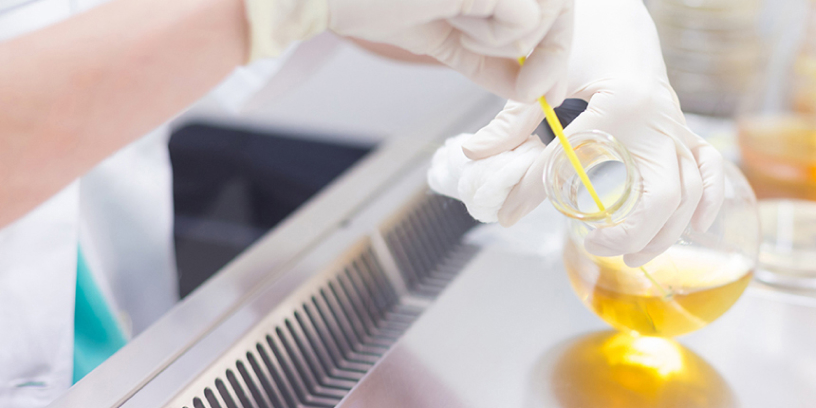EzDrop vs NanoDrop™ One / NanoDrop™ 2000 and DS-11: Performance Comparison among Micro-Volume UV/Vis Spectrophotometers
2023-04-26

EzDrop Spectrophotometer series (EzDrop 1000 and EzDrop 1000C) features fast nucleic acid/protein measurement in 3 seconds. Compared to the widely used spectrophotometers of the same level as EzDrop, including NanoDrop™ One, NanoDrop™ 2000 and DS-11, EzDrop not only performs with equal accuracy and precision in nucleic acid concentration and quality detection but also processes larger wavelength range.
Table of contents
- Introduction
- Technical Spec Comparison
- Accuracy Comparison
- Precision Comparison
- Summary
Table of contents
- Introduction
- Technical Spec Comparison
- Accuracy Comparison
- Precision Comparison
- Summary
Introduction
Spectrophotometers are widely used for scientists to detect the concentration of substances in samples. When selecting the right spectrophotometer, the key features of wavelength range, accuracy and the sample volume often play important roles.
The EzDrop Spectrophotometer series (EzDrop 1000 and EzDrop 1000C) provides fast nucleic acid and protein measurement in 3 sec. Only 1 µL of micro volume sample is required. The ratio of A260/A280 calculated simultaneously is convenient for confirming the quality of nucleic acid (DNA and RNA). Moreover, with the aid of low optical path length design, the detection concentration of dsDNA with EzDrop can be up to 20,000 ng/mL. EzDrop possesses larger wavelength range, from 190 to 1000 nm, than competitor spectrophotometers such as NanoDrop™ One (Thermo Fisher®), NanoDrop™ 2000 (Thermo Fisher®) and DS-11 (DeNovix®).
On this note, we compared the performance of EzDrop 1000 to NanoDrop™ One, NanoDrop™ 2000 and DS-11 in nucleic acid sample detection – you’ll see how the EzDrop series can help accelerate your research efficiency.
Technical Spec Comparison
Here, we chose three other models to compare with EzDrop 1000. Table 1 shows the key specifications of EzDrop 1000, NanoDrop™ One, NanoDrop™ 2000 and DS-11. It indicates that the specifications of these micro-volume UV/Vis spectrophotometers are similar. EzDrop 1000 even possesses the largest wavelength range (Table 1).

Table 1. Specification comparison of four micro-volume UV/Vis spectrophotometers.
The characteristics of four UV/Vis micro-volume spectrophotometers, EzDrop 1000 (Blue-Ray Biotech), NanoDrop™ One (Thermo Fisher®), NanoDrop™ 2000 (Thermo Fisher®) and DS-11 (DeNovix®).
Accuracy Comparison
The accuracy tests show the ability to measure the true concentration of a substance in a sample. Well-known concentration sample (10 mg/mL salmon sperm DNA, Invitrogen, Thermo Fisher®) was two-fold serial dilution, and the concentration and A260/A280 ratio of each sample were detected with the EzDrop 1000, DS-11 and NanoDrop™ 2000, shown in Table 2, and with the EzDrop 1000 and NanoDrop™ One, shown in Table 3. The R2 was also calculated from Table 2 and Table 3 and both displayed above 0.99 (Figure 1 and 2). The results prove that the accuracy of these micro-volume UV/Vis spectrophotometers was similar, demonstrating that EzDrop 1000 is a great competitor to other micro-volume spectrophotometers.

Table 2. The accuracy test among EzDrop 1000, DS-11 and NanoDrop™ 2000.
The well-known concentration sample was two-fold serial dilution. The concentration and A260/A280 ratio of each sample were detected by EzDrop 1000, DS-11 and NanoDrop™ 2000.

Table 3. The accuracy test between EzDrop 1000 and NanoDrop™ One.
The model sample was two-fold serial dilution. The concentration and A260/A280 ratio of each sample were detected by EzDrop 1000 and NanoDrop™ One.

Figure 1. The accuracy test between EzDrop 1000, DS-11 and NanoDrop 2000.
The model sample was twofold serial dilution. The concentration of each sample was detected with the EzDrop 1000, DS-11 and NanoDrop™ 2000. The R2 was calculated to represent the accuracy.

Figure 2. The accuracy test between EzDrop 1000 and NanoDrop™ One.
The model sample was two-fold serial dilution. The concentration of each sample was detected with the EzDrop 1000 and NanoDrop™ One. The R2 was calculated to represent the accuracy.
Precision Comparison
The precision tests show the ability to obtain similar results by repeating analysis on the same sample. The concentration of the model sample labeled as 2,500 ng/mL or 312 ng/mL was detected three times with the EzDrop 1000 and DS-11 individually. The concentration detected from two spectrophotometers were similar; however, the CV value from the EzDrop 1000 was more stable than that of the DS-11 under different concentrations of model sample detection (Table 4 and Figure 3). These results indicate that EzDrop 1000 is more reliable.

Table 4. The precision test between EzDrop 1000 and DS-11.
The concentration of sample with same volume was measured three times to show the reproducibility of EzDrop 1000 and DS-11 (n=3).

Figure 3. The precision test between EzDrop 1000 and DS-11.
The concentration of sample with same volume was measured three times to show the reproducibility of EzDrop 1000 and DS-11 (n=3).
Summary
NanoDrop™ One, NanoDrop™ 2000 and DS-11 are widely used micro-volume UV-Vis spectrophotometers in the labs. Although EzDrop spectrophotometer series is a newcomer, our results revealed that the accuracy was well matched to these popular micro-volume spectrophotometers. Moreover, the more stable CV value during the precision test demonstrated that EzDrop 1000 possesses better reproducibility. Additionally, though the performance of the EzDrop 1000 and DS-11 were better than the technical specifications, the measurement results of the EzDrop 1000 were more stable.
In conclusion, EzDrop spectrophotometer series (EzDrop 1000 and EzDrop 1000C) not only performs with equal accuracy and precision in nucleic acid concentration and quality detection, but it also possesses larger wavelength range compared with competitors.
Note: NanoDrop™ and NanoDrop™ One are registered trademarks of Thermo Fisher Scientific and its subsidiaries. Thermo Fisher®is a registered trademark of Thermo Fisher Scientific, Inc. DeNovix ®is a registered trademark of DeNovix Inc.




